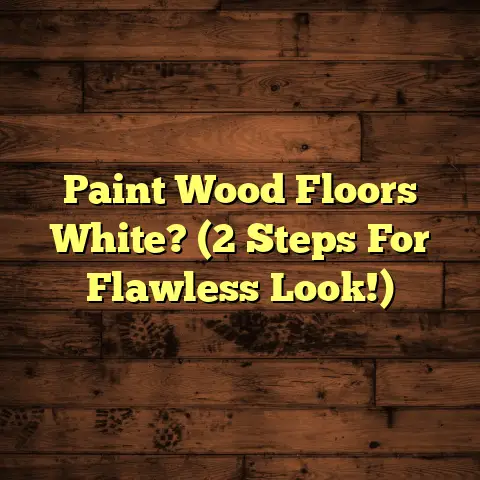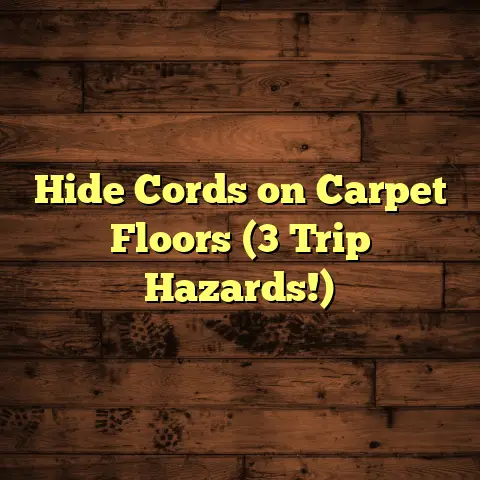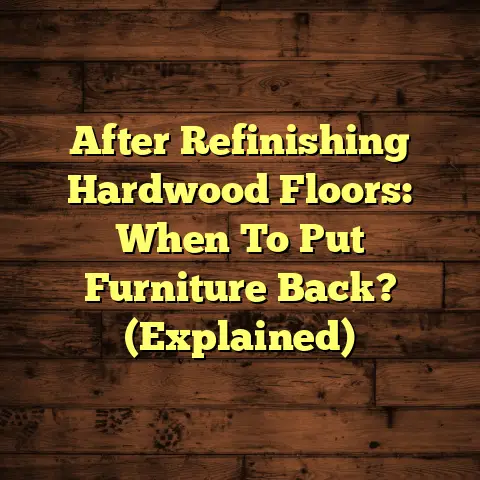Remove Scratches From Dark Floors? (3 Pro Steps!)
And let me tell you, dark floors? They’re gorgeous, but they show everything. Scratches, scuffs, you name it.
But don’t worry, I’m here to walk you through getting those floors back to their former glory.
We’re talking resale value, folks. Seriously. Think about it – what’s one of the first things potential buyers notice when they walk into a house?
The floors! According to the National Association of Realtors, homes with well-maintained hardwood floors can sell for as much as 2.5% more than those without.
That’s not chump change!
Scratched-up floors scream “neglect” and can seriously turn off buyers. I’ve seen deals fall through because of something as seemingly small as damaged flooring.
Let’s dive in and get those floors looking their best!
Section 1: Understanding the Impact of Scratches on Dark Floors
So, what kind of dark flooring are we talking about? It could be anything from solid dark hardwood, which is a classic and timeless choice, to engineered wood.
Engineered wood is a great option because it offers the look of hardwood but with better stability, especially in areas with fluctuating humidity.
Then there’s dark laminate, which is a budget-friendly and durable alternative. I’ve even seen some beautiful dark luxury vinyl plank (LVP) options that are almost indistinguishable from real wood!
No matter the type, the one thing they all have in common? Scratches are way more visible on dark surfaces. It’s just a matter of contrast.
Think about it like this: a tiny scratch on a light oak floor might blend in, but on a dark espresso floor, it’s going to stand out like a sore thumb.
These scratches can come from all sorts of things. Pets are a major culprit – those little claws can do some serious damage. Moving furniture is another big one.
Even everyday wear and tear from shoes can leave its mark. And let’s not forget the dreaded dropped object. Ouch!
When potential buyers walk into a home, they’re forming an opinion within seconds. Scratched floors create a negative first impression, suggesting the home hasn’t been well cared for.
I’ve personally witnessed buyers drastically reduce their offers because of floor damage. It’s just not worth the risk.
Section 2: Pro Step 1 – Assessing the Damage
Alright, before you start slathering stain all over the place, let’s take a good, hard look at the damage. This is where the pros separate themselves from the amateurs.
First things first, you need to identify what kind of scratches you’re dealing with. Are they just surface scratches that only affect the finish?
Or are they deep gouges that penetrate the wood itself? The type of scratch will determine the best repair method.
Grab a flashlight – a good bright one. Shine it at an angle across the floor. This will highlight even the most subtle scratches.
You might also want to grab a magnifying glass for a closer look, especially if you’re dealing with a particularly intricate grain pattern.
Now, run your hand lightly over the scratches. Do they feel smooth, or do they catch your fingernail? If they catch, they’re likely deeper scratches.
Next, you need to determine the type of finish on your floor. Is it a polyurethane finish, which is common on hardwood? Or is it a melamine finish, which is often used on laminate?
A simple test: dab a small amount of mineral spirits in an inconspicuous area. If the finish gets sticky, it’s likely polyurethane. If it doesn’t react, it’s probably melamine.
Why does this matter? Because the repair products you use need to be compatible with the finish. Using the wrong product can make the problem even worse.
I’ve seen this happen countless times. Someone tries to “fix” a scratch with the wrong product and ends up creating a bigger, more noticeable mess.
Trust me, taking the time to properly assess the damage is crucial. It’ll save you time, money, and a whole lot of frustration in the long run.
Section 3: Pro Step 2 – Choosing the Right Repair Method
Okay, now that you’ve assessed the damage, let’s talk about repair options. I’m going to give you three pro-level methods, ranging from the simplest to the most involved.
Option 1: Using a Wood Stain Marker or Crayon for Minor Scratches
This is your go-to for those superficial surface scratches. Think of it like coloring in the lines. The key here is to match the stain color to your flooring perfectly.
Take a sample of your flooring to a reputable hardware store. Most stores have color-matching technology that can help you find the exact shade you need.
Don’t just grab the first marker that looks close. Test it in an inconspicuous area first. You want it to blend seamlessly.
Once you’ve got the right marker, apply it carefully to the scratch, following the grain of the wood. Don’t overdo it. A little goes a long way.
Use a soft cloth to gently wipe away any excess stain. You want to blend the edges of the stain into the surrounding finish.
I often use a circular motion to achieve a natural look. Let the stain dry completely according to the manufacturer’s instructions.
For crayons, warm the tip slightly with your finger to soften the wax. Then, rub the crayon into the scratch, again following the grain.
Use a plastic putty knife or an old credit card to remove any excess wax. Buff the area with a soft cloth to blend.
This method is quick, easy, and relatively inexpensive. It’s perfect for hiding those minor blemishes that can make your floors look worn.
Option 2: Applying a Wood Filler or Putty for Deeper Scratches
For scratches that penetrate the finish and reach the wood itself, you’ll need something more substantial than a stain marker. That’s where wood filler comes in.
Again, color matching is crucial. You can find wood fillers that are pre-tinted, or you can mix your own using universal tints.
I prefer to mix my own because it allows me to achieve a truly custom match. Start with a small amount of filler and gradually add tint until you get the desired color.
Before you apply the filler, clean the area around the scratch with a damp cloth. This will help the filler adhere properly.
Use a small putty knife to apply the filler to the scratch. Overfill slightly, as the filler will shrink as it dries.
Allow the filler to dry completely according to the manufacturer’s instructions. This can take several hours, or even overnight.
Once the filler is dry, sand it smooth with fine-grit sandpaper (220-grit or higher). Be careful not to sand the surrounding finish.
I recommend using a sanding block to ensure a flat, even surface. After sanding, clean the area with a tack cloth to remove any dust.
Finally, you’ll need to reapply the finish to the filled area. Use a small brush or a cotton swab to apply a thin, even coat of finish.
Let the finish dry completely and then apply a second coat if necessary. This will help blend the repaired area with the surrounding floor.
Option 3: Refinishing the Area or the Entire Floor if Scratches are Extensive
When scratches are widespread or deep, spot repairs might not cut it. In these cases, refinishing is the best option.
This is a more involved process, but it can completely transform your floors and restore them to their original beauty.
Refinishing involves sanding down the existing finish, staining the wood (if desired), and then applying several coats of a protective finish.
I always recommend hiring a professional for this job, especially if you’re dealing with hardwood floors. Sanding incorrectly can damage the wood and create an uneven surface.
However, if you’re a confident DIYer, you can tackle this project yourself. Just be sure to do your research and invest in the right tools.
Safety is paramount. Wear a respirator to protect yourself from dust and fumes. Also, make sure the area is well-ventilated.
The first step is to sand the floor. Start with a coarse-grit sandpaper (36-grit) to remove the old finish. Then, move to a medium-grit sandpaper (80-grit) to smooth out the surface.
Finally, use a fine-grit sandpaper (120-grit) to prepare the floor for staining and finishing. After sanding, thoroughly clean the floor with a vacuum and a tack cloth.
If you’re staining the floor, apply the stain evenly with a brush or a rag. Let the stain dry completely according to the manufacturer’s instructions.
Finally, apply several coats of polyurethane finish. Let each coat dry completely before applying the next. Lightly sand between coats with fine-grit sandpaper to create a smooth, even surface.
Refinishing is a significant undertaking, but it’s the most effective way to restore severely damaged floors. It’s an investment that will pay off in the long run, both in terms of aesthetics and resale value.
Section 4: Pro Step 3 – Preventing Future Scratches
Okay, you’ve fixed your scratched floors. Great! Now, let’s talk about preventing those scratches from coming back. Prevention is always better than cure, right?
The easiest way to protect your floors is to use area rugs. Place rugs in high-traffic areas, such as hallways, entryways, and living rooms.
Rugs not only protect your floors from scratches, but they also add warmth and style to your home. It’s a win-win!
Another essential is furniture pads. Place felt pads under the legs of all your furniture, especially chairs and tables that are frequently moved.
These pads will prevent furniture from scratching the floor when you slide it around. I also recommend using larger pads for heavier items, like sofas and dressers.
Proper cleaning techniques are also crucial. Avoid using harsh chemicals or abrasive cleaners, as these can damage the finish on your floors.
Instead, use a pH-neutral cleaner specifically designed for your type of flooring. I always recommend reading the manufacturer’s instructions carefully before cleaning.
When mopping, use a damp mop, not a soaking wet one. Excess water can seep into the seams of your flooring and cause damage.
Maintaining proper humidity levels is especially important for wooden floors. Extreme fluctuations in humidity can cause wood to expand and contract, leading to cracks and scratches.
I recommend investing in a humidifier or a dehumidifier to keep the humidity level in your home between 30% and 50%.
Finally, regular maintenance is key. Sweep or vacuum your floors regularly to remove dirt and debris. This will prevent those tiny particles from scratching the finish.
You can also polish your floors periodically to restore their shine and protect them from wear. Use a polish specifically designed for your type of flooring.
By taking these preventive measures, you can keep your dark floors looking beautiful for years to come. It’s an investment in the long-term value of your home.
Conclusion
So, there you have it – my pro guide to removing scratches from dark floors. Remember, maintaining your floors is about more than just aesthetics. It’s about preserving the value of your home.
By following these steps, you can effectively remove scratches and prevent future damage, ensuring that your floors remain a valuable asset for years to come. Don’t wait until those scratches become a major problem.
Take proactive measures now to care for your floors and protect your investment. Your wallet (and your potential buyers) will thank you!





